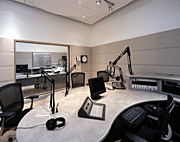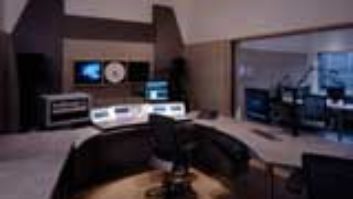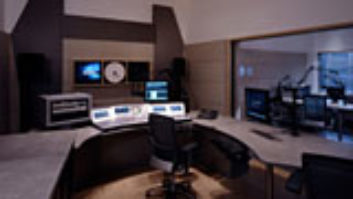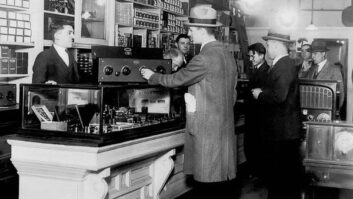
A station such as San Francisco’s KQED-FM — which is consistently ranked as one of the most listened to public radio stations in the nation, with more than 780,000 listeners each week — deserves an interruption-free, crystal-clear signal. Likewise, the announcers, hosts, reporters and producers that drive this station need top-notch equipment and a comfortable environment that aids efficient workflow and quick response time.
KQED’s multipurpose live air studio home of everything from pledge drives to talk shows
photos: RBDG.com
For this 35-year-old radio station, significant upgrades — everything from a cosmetic facelift to a complete equipment overhaul — needed to happen so that the facility met the station’s historically high standards. One five-year, $70 million fundraising campaign and a two-and-a-half-year renovation process later, KQED operates out of all-digital, ergonomically correct TV and radio facilities that affirm the strength of public broadcasting, especially in the Bay Area.
While most of the fundraising proceeds went toward upgrading the television facilities, approximately $4 million was bookmarked for renovating the radio rooms and to purchase and install the equipment needed to convert its radio transmission from analog to digital. The transition included installing a new HD transmitter and digital consoles, as well as constructing a new master control room, production suite and edit bay, and extensively remodeling the four existing production suites.
“We had a few goals,” says Dan Mansergh, KQED Public Radio director of engineering. “We wanted to ‘get digital,’ but we took that mandate fairly broadly. We said, ‘Let’s see how we can improve all aspects of our operation, not just digital audio or digital broadcast. We also have to look at the Web and other distribution media as potential destinations for our programming, and we have to have the infrastructure to not only provide the audio, but also the metadata to go along with that.”
“From a technical standpoint, they had to establish an infrastructure for both TV and radio that would work together,” adds Richard Schrag, an associate at Dallas-based Russ Berger Design Group, who oversaw the project’s architectural and design elements. “They really thought through their resources — not only in terms of equipment and how the spaces are tied together technically, but also in terms of how the spaces are used. There are large areas in the facility used for pre-production, and they are considering broadcasting a video feed of some of the radio shows via TV or the Web.”
KQED’s Master Control center features an ergonomic, spacious design built around a Studer OnAir 2000M2 console.
On the technical side, the company installed a Dalet Digital Media Systems broadcast automation and a news production database system that runs on 10 IBM XSeries eServers and a FastT200 SAN storage system, networked with 20 Dell Precision workstations (for the studios and control rooms) and 45 Dell Optiplex desktops for reporters, producers and operations staff. Audio routing is handled by a fully loaded Sierra Automated Systems 32KD 256×256 digital audio network, which resides with the servers, KVM system, satellite equipment, and STL and processing equipment in a central machine room.
Inside the control rooms, KQED wanted a flexible system that could handle multiple tasks, including pulling from satellite feeds or other outside destinations, without endless rewiring and with a short learning curve. The first step in accomplishing this task was replacing its Pacific Recorders BMXII consoles with Studer OnAir 2000M2 digital mixers.
“We’re dealing with a station that’s been around for more than 30 years, so there’s a certain expectation about how a board should work,” says KQED’s Mansergh. “So we started looking at more traditional broadcast boards. The [Studer] does what you expect it to, just some of the controls are a bit different. You can store all of your settings as presets or assign them to a particular show configuration. If you know that a particular host needs EQ, you can store their mic setting with a particular show setup. Also, an engineer can come in and no matter what anybody’s done before, can just hit a couple of buttons and know that the board is back to the way he or she expects it. That’s a real big advantage.
“For a traditional news production, you need computer sources from various output channels, a couple of mics and a CD player,” continues Mansergh. “You’re not using all the mics in the studio, so you can configure the board so you’ve got your core stuff at the center. Then, when you want to do a talk show, you can put all of your mics and ‘phones in close and move the other stuff farther out.”
Despite the board’s short learning curve, the transition from analog to digital had to happen gradually to give the staff time to get used to the new desks and keep the station operational throughout the process. “We were changing everything about what we were doing,” says Mansergh. “We tried to emulate the existing workflow, which helped the transition a lot. Now people are starting to really get creative about how to use [the new systems], which was one of our goals: to streamline things and add flexibility.”
In addition to a simplified workflow, KQED Radio wanted to improve its surroundings by building a new master control room and main production suite, and remodeling the rest of the studio area. The company brought in Russ Berger Design Group to oversee the architectural and design elements of the new Master Control area and the older control room and studio renovation. Glendale, Calif.-based National Teleconsultants, who also worked on the KQED-TV upgrade, was brought in to develop a technical plan and provide installation documentation.
One of the design firm’s goals was to create cohesion between KQED’s new and existing spaces, as if “one hand touched everything,” explains Schrag. “They had existing construction that they thought was okay in terms of sound isolation, mechanical systems and electrical systems, so we didn’t have to start from scratch with the basic infrastructure.”
The Russ Berger Design Group crew converted a corner of office space and some underused technical rooms into a new 20×16, 5.1-capable master control room, a 14×15 multipurpose live air studio and two digital edit booths. Installing new lighting and a large exterior window in the studio and another window leading into Master Control helped eliminate the former space’s “oppressive” feeling.
In addition to the Studer desks and a Genelec 1031 monitoring system, the trapezoidal-shaped main control room features a 20-inch flat-screen video monitor, a full complement of audio players, remote control and production equipment, and creature comforts such as storage space for announcers’ belongings, a U-shaped workspace with room to spread out paperwork and/or set up a laptop and a hydraulic centerpiece for the Studer console that can be raised or lowered, depending on whether an announcer prefers to stand or sit at the mic. The room is built on a floating floor, which was tricky to install, to say the least; one, because the studios occupy the second floor of a three-story building and two, the space had to be designed for earthquake safety.
“We had to drill holes into the post-tension concrete slab on the second floor, then build plywood bases for the concrete slabs,” explains Mansergh. “Then there’s steel edging that the walls attach to. It’s a really complex puzzle and to make it structurally stable enough, there was a lot of bracing that went into it. Just getting the floors done was a pretty substantial process. You’ve got all this noise, people are cutting steel and we’re trying to keep it all isolated [from the rest of the studios]. Our staff was very patient.”
“Any time you’re on the upper floor of a multistory building, sound isolation from the building structure is going to be essential,” Schrag explains. “But the seismic requirements [for earthquake safety] for the new construction were at odds with what we wanted to accomplish acoustically. We wanted the rooms to be completely floating from the building, but the structural engineer required them to be firmly tied down so that they don’t hop around in case of an earthquake. So we had to develop a great number of specialized details for providing the limits on the movement of those individual construction components without negating the acoustic benefits of having everything floating.”
As one can imagine, phase one of KQED’s upgrade — the Master Control area — took the longest to complete, partly due to the extensive work involved, but mostly because of scheduling and making sure KQED remained on the air 24 hours a day (without the roar of cutting steel in the background). “We had to keep the old rooms operational while we built the new ones and move people into the new ones gradually, so we had duplicate systems running,” says Mansergh. “We had to do production on tape in some of these rooms, while the computers were sitting in the rack already running. It was quite a tap dance.”
In an effort to maintain its already well-regarded reputation in the Bay Area (as one might expect, an NPR-friendly environment that’s especially interested in current events in its own backyard and the world at large), KQED radio plans to expand its local production, which already fills a substantial 20 percent of its daily programming. The station also has more to do on the technical side, such as install the HD transmitter for its Sacramento, Calif., satellite station, KQEI, not to mention a recently purchased Studer OnAir 500 Modulo for the Sacramento bureau studio.
At a time when satellite radio is gaining ground over commercial FM stations and when MP3 players seem to have squashed radio’s popularity altogether, KQED’s commitment to community just may give it the edge needed to keep the company at the top of its game.
“We really encourage our clients to future-proof their place — to realize that they’re not building for today, they’re building for 15, 20 years out because that’s how long these facilities last,” says Russ Berger, whose company has worked with more than 60 public radio stations nationwide. “Public radio is such a vital part of life in so many parts of the country. It’s real. It’s visceral. You can drive down to the station and see the people you hear on the air. It’s the last real live broadcast medium.”
Heather Johnson is an assistant editor at Mix.






